Page 211 of 297

3 WHAT TO DO IN AN EMERGENCY
4
!
!
IF THE ENGINE OVERHEATS
(If the air conditioning had been in use, it is normal for cold water to bedraining from it when you stop).
D030A01TG-AAT If your temperature gauge indicates overheating, you experience a loss of power, or hear loud pinging or knock- ing, the engine is probably too hot. Ifthis happens to you, you should:
1. Pull off the road and stop as soon as
it is safe to do so.
2. Place the gear selector lever in "P"
and set the parking brake. If the air conditioning is on, turn it off.
3. If engine coolant is running out under
the car or steam is coming out fromthe hood, stop the engine. Do not open the hood until the engine coolant has stopped running or thesteaming has stopped. If there is no visible loss of coolant and no steam, leave the engine running and checkto be sure the engine cooling fan is operating. If the fan is not running, turn the engine off.
4. Check to see if the water pump drive belt is missing. If it is not missing,check to see that it is tight. If thedrive belt seems to be satisfactory, check for engine coolant leaking from the radiator, hoses or under the car.
6. Carefully remove the jumper cables
in the reverse order of attachment.
If you do not know why your batterybecame discharged (because the lightswere left on, etc.), have the charging system checked by your Hyundai dealer. WARNING:
While the engine is running, keephands and clothing away from mov-ing parts such as the fan and drive belts to prevent injury.
5. If the water pump drive belt is broken or coolant is leaking out, stop theengine immediately and call the near- est Hyundai dealer for assistance.
WARNING:
Do not remove the radiator cap whenthe engine is hot. This can allow coolant to be blown out of the open- ing and cause serious burns.
Page 215 of 297
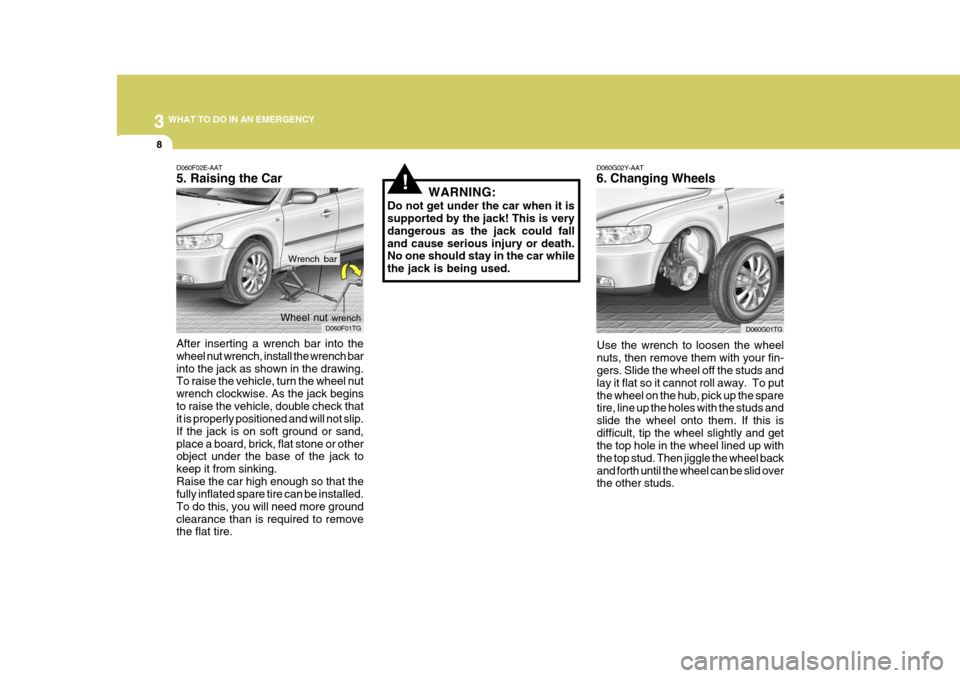
3 WHAT TO DO IN AN EMERGENCY
8
!
D060G02Y-AAT 6. Changing Wheels
Use the wrench to loosen the wheel nuts, then remove them with your fin- gers. Slide the wheel off the studs and lay it flat so it cannot roll away. To putthe wheel on the hub, pick up the spare tire, line up the holes with the studs and slide the wheel onto them. If this isdifficult, tip the wheel slightly and get the top hole in the wheel lined up with the top stud. Then jiggle the wheel backand forth until the wheel can be slid over the other studs.
D060F02E-AAT 5. Raising the Car After inserting a wrench bar into the wheel nut wrench, install the wrench barinto the jack as shown in the drawing. To raise the vehicle, turn the wheel nut wrench clockwise. As the jack beginsto raise the vehicle, double check that it is properly positioned and will not slip. If the jack is on soft ground or sand,place a board, brick, flat stone or other object under the base of the jack to keep it from sinking.Raise the car high enough so that the fully inflated spare tire can be installed. To do this, you will need more groundclearance than is required to remove the flat tire. WARNING:
Do not get under the car when it issupported by the jack! This is very dangerous as the jack could falland cause serious injury or death. No one should stay in the car while the jack is being used.
D060F01TG
Wheel nut
wrench
D060G01TG
Wrench bar
Page 216 of 297
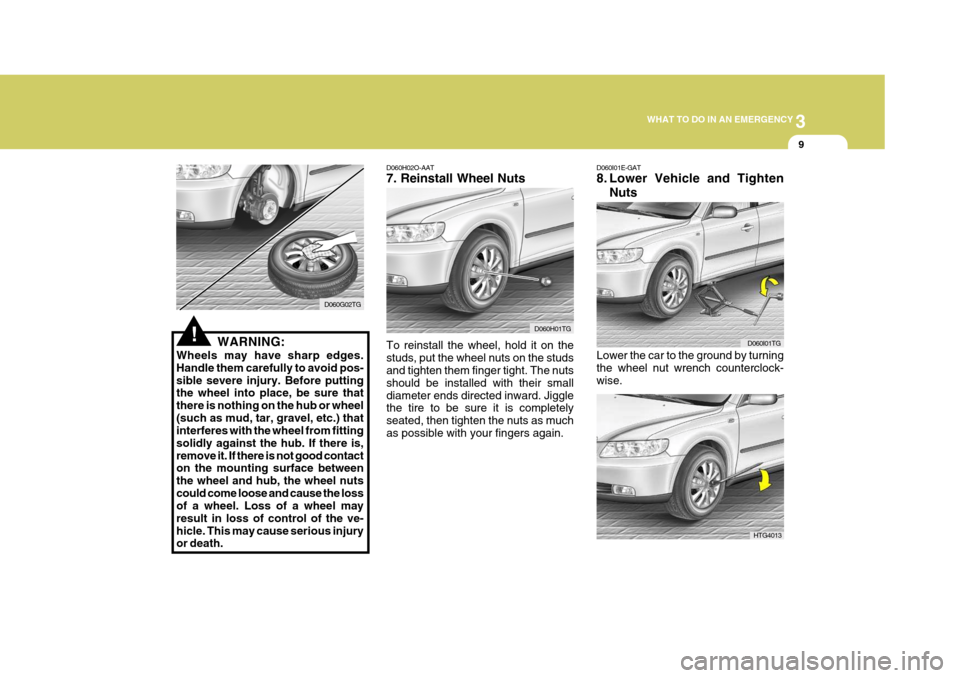
3
WHAT TO DO IN AN EMERGENCY
9
!WARNING:
Wheels may have sharp edges. Handle them carefully to avoid pos-sible severe injury. Before putting the wheel into place, be sure that there is nothing on the hub or wheel(such as mud, tar, gravel, etc.) that interferes with the wheel from fitting solidly against the hub. If there is,remove it. If there is not good contact on the mounting surface between the wheel and hub, the wheel nutscould come loose and cause the loss of a wheel. Loss of a wheel may result in loss of control of the ve-hicle. This may cause serious injury or death. D060G02TG
Lower the car to the ground by turning the wheel nut wrench counterclock- wise.
D060I01E-GAT
8. Lower Vehicle and Tighten
Nuts
D060H02O-AAT7. Reinstall Wheel Nuts To reinstall the wheel, hold it on the studs, put the wheel nuts on the studs and tighten them finger tight. The nuts should be installed with their smalldiameter ends directed inward. Jiggle the tire to be sure it is completely seated, then tighten the nuts as muchas possible with your fingers again. D060H01TG
D060I01TG
HTG4013
Page 240 of 297
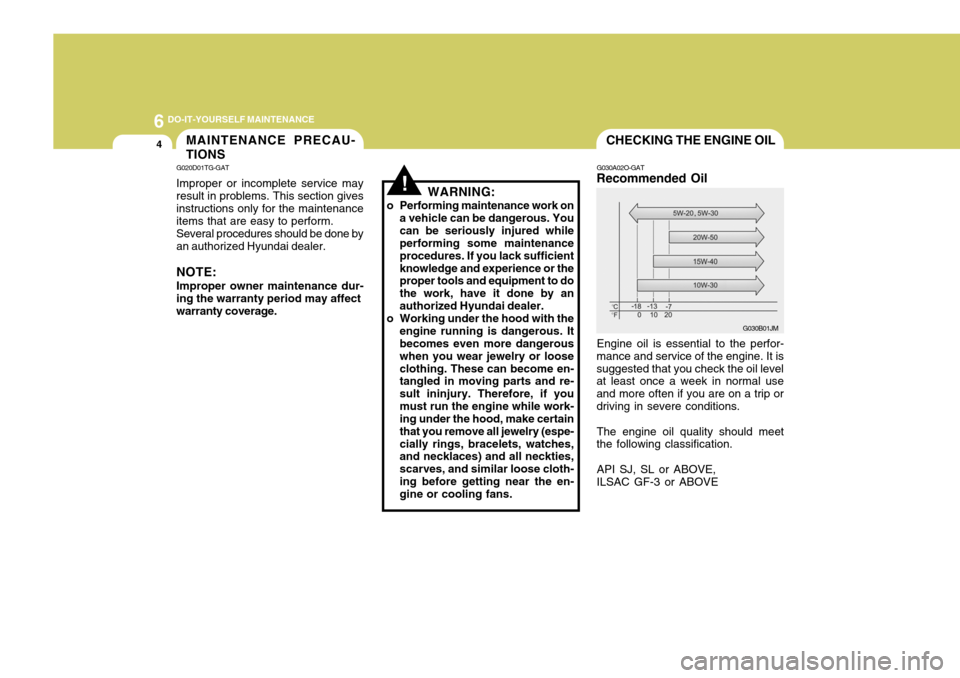
6 DO-IT-YOURSELF MAINTENANCE
4MAINTENANCE PRECAU- TIONS
!
G020D01TG-GAT Improper or incomplete service may result in problems. This section gives instructions only for the maintenanceitems that are easy to perform.Several procedures should be done byan authorized Hyundai dealer. NOTE: Improper owner maintenance dur- ing the warranty period may affectwarranty coverage. WARNING:
o Performing maintenance work on a vehicle can be dangerous. Youcan be seriously injured while performing some maintenance procedures. If you lack sufficientknowledge and experience or the proper tools and equipment to do the work, have it done by anauthorized Hyundai dealer.
o Working under the hood with the engine running is dangerous. It becomes even more dangerous when you wear jewelry or looseclothing. These can become en- tangled in moving parts and re- sult ininjury. Therefore, if youmust run the engine while work- ing under the hood, make certain that you remove all jewelry (espe-cially rings, bracelets, watches, and necklaces) and all neckties, scarves, and similar loose cloth-ing before getting near the en- gine or cooling fans.
CHECKING THE ENGINE OIL
G030A02O-GAT
Recommended Oil
Engine oil is essential to the perfor-
mance and service of the engine. It is suggested that you check the oil level at least once a week in normal use and more often if you are on a trip ordriving in severe conditions.
The engine oil quality should meet
the following classification.
API SJ, SL or ABOVE, ILSAC GF-3 or ABOVE G030B01JM
Page 241 of 297
6
DO-IT-YOURSELF MAINTENANCE
5
NOTE:
o For good fuel economy, SAE 5W-20 (5W-30), ILSAC GF-3 en- gine oil is preferred regardless of regional option and engine variation.
o If SAE 5W-20, ILSAC GF-3 en- gine oil is not available, second-ary recommended engine oil forcorresponding temperature range can be used.
Before checking the oil, warm up the
engine to the normal operating tem- perature and be sure your car is parked on level ground. Turn the en-gine off.
Wait about five minutes, then remove
the dipstick, wipe it off, fully reinsertthe dipstick and withdraw it again.Then note the highest level the oil has reached on the dipstick. It should be between the upper ("F") and lower("L") range.
G030C02JM-AAT
To Check the Oil Level
G030C01TGWARNING:
Be very careful not to touch the radiator hose when checking the engine oil as it may be hot enoughto burn you.
!
Page 242 of 297
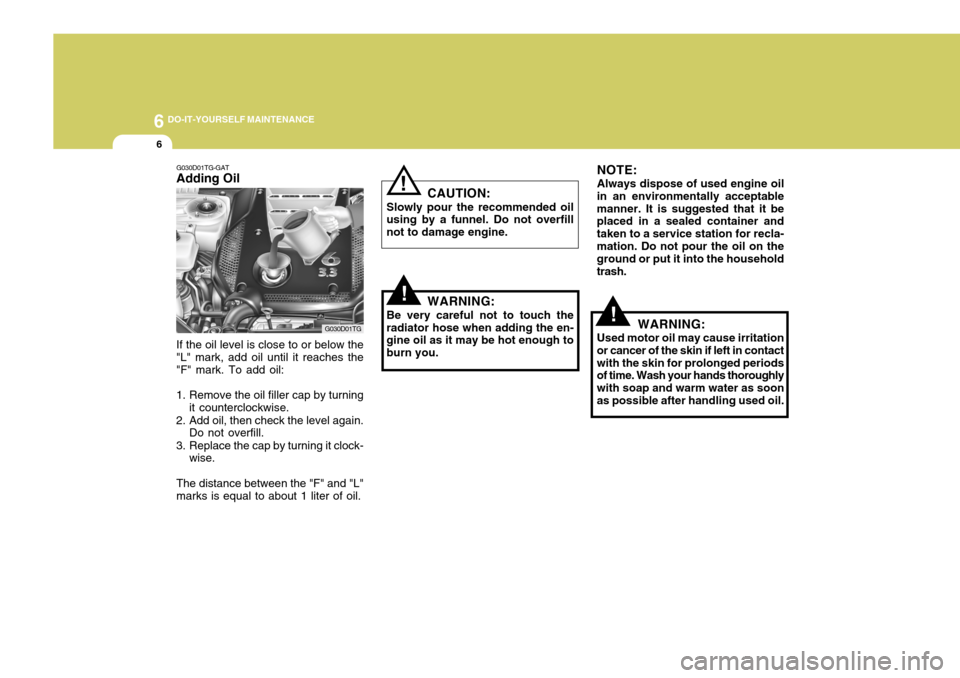
6 DO-IT-YOURSELF MAINTENANCE
6
!
!
CAUTION:
Slowly pour the recommended oil using by a funnel. Do not overfill not to damage engine.
WARNING:
Be very careful not to touch theradiator hose when adding the en- gine oil as it may be hot enough to burn you.! NOTE: Always dispose of used engine oil
in an environmentally acceptable manner. It is suggested that it be placed in a sealed container and taken to a service station for recla-mation. Do not pour the oil on the ground or put it into the household trash.
WARNING:
Used motor oil may cause irritationor cancer of the skin if left in contactwith the skin for prolonged periods of time. Wash your hands thoroughly with soap and warm water as soonas possible after handling used oil.
G030D01TG-GAT Adding Oil If the oil level is close to or below the "L" mark, add oil until it reaches the "F" mark. To add oil:
1. Remove the oil filler cap by turning it counterclockwise.
2. Add oil, then check the level again. Do not overfill.
3. Replace the cap by turning it clock- wise.
The distance between the "F" and "L" marks is equal to about 1 liter of oil. G030D01TG
Page 243 of 297
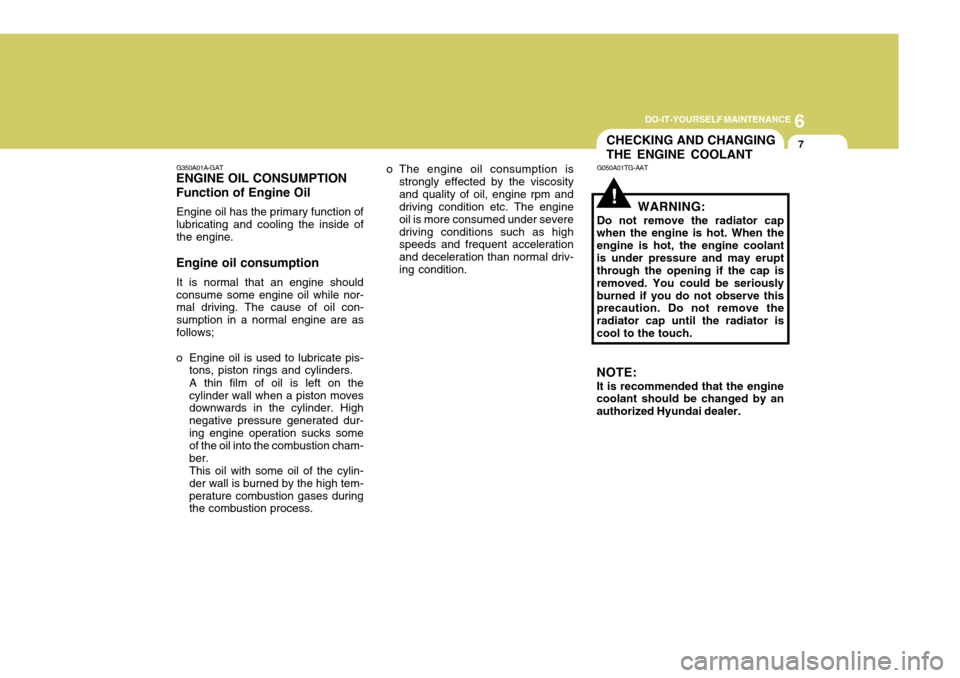
6
DO-IT-YOURSELF MAINTENANCE
7
G350A01A-GAT
ENGINE OIL CONSUMPTION Function of Engine Oil
Engine oil has the primary function of lubricating and cooling the inside of the engine.
Engine oil consumption It is normal that an engine should consume some engine oil while nor- mal driving. The cause of oil con- sumption in a normal engine are asfollows;
o Engine oil is used to lubricate pis- tons, piston rings and cylinders. A thin film of oil is left on the cylinder wall when a piston moves downwards in the cylinder. High negative pressure generated dur-ing engine operation sucks some of the oil into the combustion cham- ber.This oil with some oil of the cylin-der wall is burned by the high tem-perature combustion gases during the combustion process. o The engine oil consumption is
strongly effected by the viscosity and quality of oil, engine rpm and driving condition etc. The engine oil is more consumed under severedriving conditions such as high speeds and frequent acceleration and deceleration than normal driv-ing condition.
!
CHECKING AND CHANGING THE ENGINE COOLANT
G050A01TG-AAT
WARNING:
Do not remove the radiator cap
when the engine is hot. When the engine is hot, the engine coolantis under pressure and may erupt through the opening if the cap is removed. You could be seriouslyburned if you do not observe this precaution. Do not remove the radiator cap until the radiator iscool to the touch.
NOTE: It is recommended that the engine coolant should be changed by an authorized Hyundai dealer.
Page 245 of 297

6
DO-IT-YOURSELF MAINTENANCE
9
!WARNING:
The cooling fan is controlled by engine coolant temperature and may sometimes operate even when theengine is not running. Use extreme caution when working near the blades of the coolant fan so that youare not injured by a rotating fan blade. As the engine coolant tem- perature decreases, the fan will au-tomatically shut off. This is a nor- mal condition.
SPARK PLUGS
G060A01TG-GAT
G060A01L
Your engine was originally equipped with Iridium-tipped spark plugs (For unleaded only).Iridium-tipped spark plugs will lastlonger than conventional type sparkplugs and can be identified by blue lines on the ceramic shell. NOTE: Do not clean or regap Iridium- tipped spark plugs. G060B01TG-GAT Replacing the Spark Plugs The spark plugs should be changed at the intervals specified in the ve- hicle maintenance schedule in Sec- tion 5 or whenever engine perfor-mance indicates they should be changed. Symptoms that suggest poor spark plug performance include en-gine misfiring under load, loss of fuel economy, poor acceleration, etc. When spark plugs are replaced, al-ways use spark plugs recommended by Hyundai. The use of other spark plugs can result in loss of perfor-mance, radio interference or engine damage. NOTE:
o It is recommended that spark
plugs should be changed by an authorized Hyundai dealer.
o When replacing the spark plugs,
always use the genuine parts rec- ommended.
Unleaded : 1.0~1.1 mm Leaded : 0.7~0.8 mm